Can all calories be painted by same brush? The story of two sugars and fat.
If you break down a system into its individual parts, can you always sum the parts to get the system back?
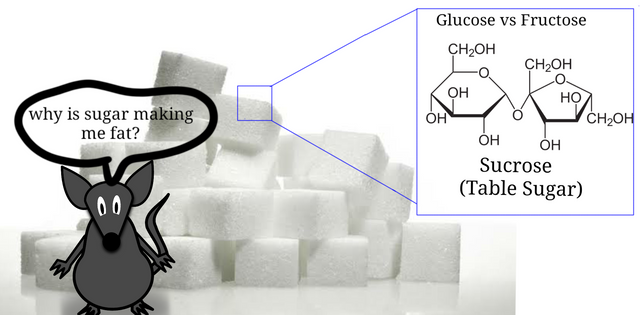
Illustrated by @scienceblocks, using following images -
Fat mouse by Clker-Free-Vector-Images and Sugar by Humusak | Pixabay
Sucrose by NEUROtiker | Public Domain
The paper
The paper we will discuss today is titled - Dietary Sugars Alter Hepatic Fatty Acid Oxidation via Transcriptional and Post-translational Modifications of Mitochondrial Proteins. is published by Softic et al., recently in Cell Metabolism.
Background
Nutrition is a complicated science. For one it is really difficult to delineate the effects micronutrients. Second, the combination of different nutrients may give entirely different results than if we were to study them alone. A usual crude method in the field of nutrition is calorie restriction. Caloric restriction is known to reduce weight and may even increase lifespan (see my previous post). However, this crude approach doesn't tell us what the individual molecules of what calories are made of do to the body. For instance, is eating X calories of fat the same as eating X calories of sugar? Is eating X calorie of glucose the same as eating X calories of the fruit sugar fructose? What about eating fat and sugar together? Or consuming sugar in solid vs liquid form? What about consuming sugar in fruits vs in sweets?
And, these questions are important esp if we are to develop efficient and safe diet plans for whatever purpose. For instance, some people who don't go for a calorie-counting diet go for something called a keto diet. Now it is known that high fat and high carb diet is obesogenic while removing carbs from the diet and just have fat (keto) is healthy. But the jury on keto is still not out yet. When it comes to glucose tolerance and type 2 diabetes, the keto diet has the potential to be worse than obesogenic diet (Grandl et al., 2018). Well, at least in mice. Hence it becomes quite important to know which nutrients we should avoid, how much and when?
Evidence has been accumulating that sugars are really bad for you. Given the high prevalence of obesity across the globe people are now calling for policies and intervention to control sugar consumption by the public (Gostin, 2018). In fact, it had been shown that consumption of that sugary soda with your meal is a really bad idea. It doesn't just add to your calorie intake but also reduces the burning of fat in your body (Casperson et al., 2017). But does that mean should we completely avoid sugars and carbs in our diet? Especially, given the above evidence about the negative effects of the keto diet in animals is it really a good idea?
The answer is complicated. Turns out not all sugars are the same. Moreover, the nutrients in the diet have a synergistic effect. What I mean to say is that you might be consuming the same amount of calories as your best friend, but it's possible that your best friend is lean and you are not. There can be differences in your genetic makeup, hormone profile, immune profile, gut microbiome, or dietary habits. His calories may come from fruits, while you may be drinking sodas. He may be having glucose water after the gym, while you might be drinking milkshakes. The question that arises from this is that, is it possible to say have same biological makeup, same calories and yet be obese because of the wrong type of sugar, its source and having it in combination with some other nutrient?
Well, at least we are beginning to get some glimpses from our friend - Mus musculus (mouse). Let's just start by saying that all sugars should not be painted with the same brush. For instance, take glucose and fructose, the two sugars present in the sugar you have in your kitchen. Turns out, glucose might not be the same as fructose when it comes to how it changes cellular functions. They may even differ in its combination. And, it may also matter whether you consume them with fat or alone.
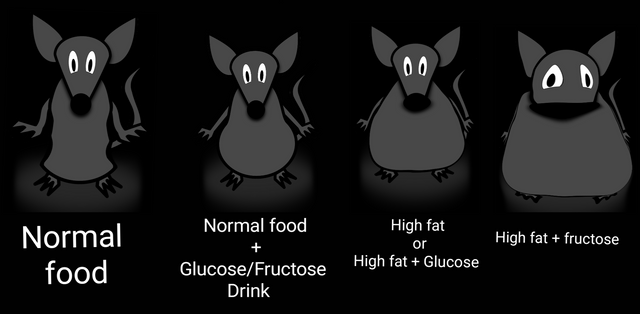
Fat mouse by Clker-Free-Vector-Images | Pixabay.
Back in 2017, Samir Softic et al., delineated the effect of fructose and glucose, with and without fat, on obesity and liver function. They found that both glucose and fructose alone led to same weight gain profile when taken with a normal diet. However, when consumed along with fat, fructose led to much higher weight gain, while glucose had no effect (even when the mice consumed the same amount of calories). Moreover, fructose combined with a high-fat diet also caused increased lipogenesis (synthesis of fat) and insulin resistance. So not only was there a caloric excess in fat plus fructose, but the mice were synthesising more fat, as well. This may explain why fructose or fructose-containing sugar in your kitchen or even high fructose corn syrup are infamous for obesity, fatty liver disease and even type 2 diabetes. The question that arises here is how? What possible mechanism can explain the differential effects of two sugars?
I mean, both are six-carbon sugars. Both have the same caloric value. Then why are they acting differently? It might be because their molecular arrangement and 3D structure are different from each other. This difference may cause to them to interact with different cell receptors in liver cells (and other cells of the body). Which may eventually lead to different molecular pathways being activated. For instance, Softic et al., 2019 recently revealed that not only does fructose increase the synthesis of lipids but it also blocks liver cells from burning more fat. Turns out, that they affect the mitochondria differently (the cell organelle known to derive energy out of food). But how exactly?
The story of sugars and mitochondria
To understand this you might need a bit background on how fat is burned in the mitochondria. Fats are composed of fatty acids of varying sizes. These fatty acids are taken up by the cell and attached to a molecule of carnitine. Then, the fatty acid-carnitine complex is transported inside mitochondria by protein machines known as CTP1 and CTP2. Inside the mitochondria the carnitine part is replaced by Coenzyme A (CoA) molecule, forming fatty acyl-CoA. Acyl-CoA then enters the pathway of beta-oxidation, which breaks down the fatty acid to yield energy.
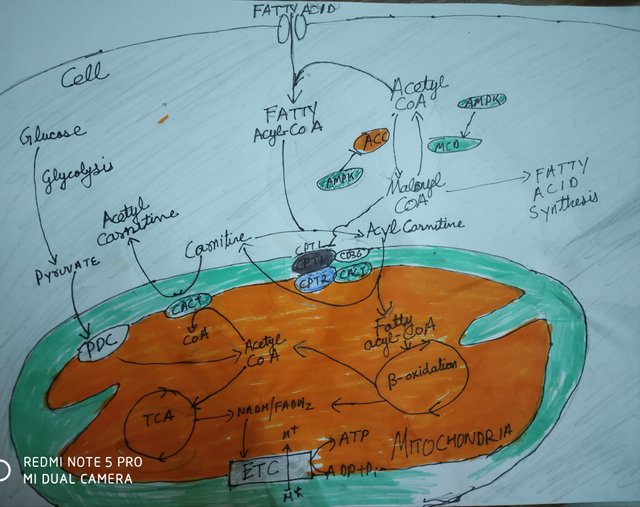
Drawn by @scienceblocks
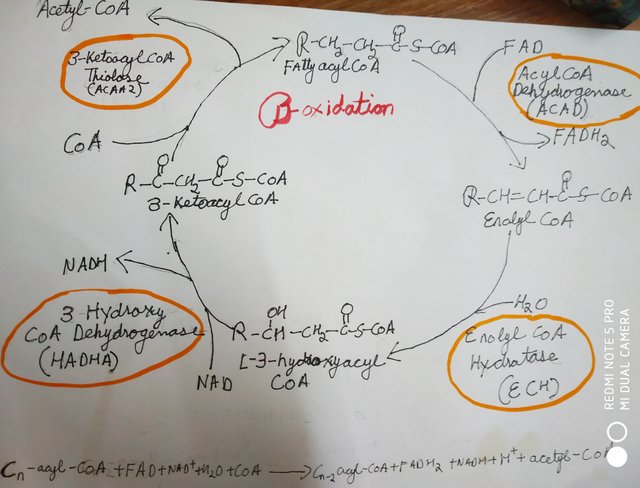
Drawn by @scienceblocks
Acyl-carnitine accumulates in fructose-fed mice.
Softic et al., observed that there was an accumulation of acyl-carnitines in the liver of mice drinking water supplemented with fructose, or eating a high-fat diet, or both. This was not the case with mice eating a normal chow diet or mouse drinking glucose with a normal chow diet.
Different sugars different AMPK activity
AMPK is an enzyme found in the cytoplasm of the cells. This enzyme is known to activate another enzyme known as MCD, which converts malonyl-CoA to acetyl-CoA. It also inhibits another enzyme ACC1, which converts acetyl-CoA to malonyl-CoA. The malonyl-CoA is an intermediate in the synthesis of fatty acids which we know is activated by fructose. Moreover, malonyl-CoA also inhibits the transport of fatty acids into the mitochondria, by inhibiting CPT1. The authors found that malonyl-CoA is high in both mice eating a high-fat diet or high-fat diet with fructose, but not with glucose. This was also supported by decreased AMPK and ACC1 levels in mouse eating a high-fat diet. However, the decrease was not as much in mouse having glucose with a high-fat diet. It seems like glucose had a rather protective effect as compared to fructose. However, the authors suggest that these decreased AMPK levels can be explained by high insulin levels (a pre-diabetic condition) observed in fructose-fed animals.
Different diet means a different gene expression profile.
Moreover, the authors further tested the effect of glucose and fructose by doing an RNA sequencing of liver cells of these eating different diets. They found a stark difference in overall fatty acid oxidation gene expression levels in mice on different diets. While glucose fed mice showed an increase in expression of genes involved in better metabolism, fructose, on the other hand, inhibited genes involved in fatty acid oxidation. Nevertheless, blocking the fructose metabolism by knocking down fructohexokinase (aka ketohexokinase or KHK) led to the improvement of fatty acid oxidation. It led to an increase in expression of fatty acid oxidation genes, including that of fatty acid transporter CTP1.
Breaking the mitochondria in small pieces.
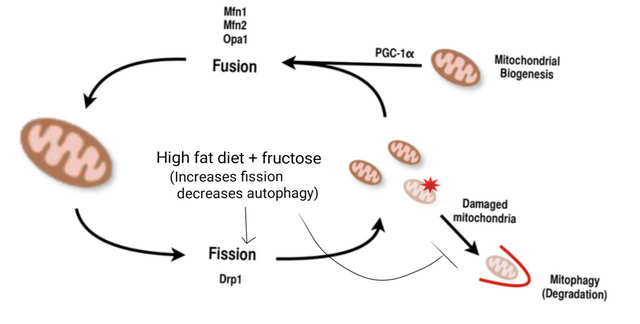
Adapted from Image by Rtian96 | CC BY-SA 4.0
Furthermore, the fructose and high-fat diet not only affects the genes involved in fatty acid oxidation, but they also change mitochondrial function and morphology. They observed an increase in the number of mitochondria in animals having a high-fat diet with fructose, but these mitochondria were comparatively smaller in size as compared to other groups. This effect was blocked by inhibiting fructose metabolism in the liver. The mitochondria in our cells undergo the process of fission and fusion. In the former case, the mitochondria break apart giving rise to many smaller mitochondria. It seems that these genes required for mitochondrial fission were increased in fructose-fed mice. Also, the fructose exposed cells seemed to be unable to get rid of small damaged mitochondria. On one hand, this would affect the overall metabolism of liver cells, on the other hand, the damaged mitochondria are known to damage the cells and surrounding tissue. This may explain why obesity is linked with all the inflammation and even liver cirrhosis which follows fatty liver disease (see previous blogs - this and this)
The protein profile of mitochondria
Finally, the authors also show that overall protein production in mitochondria is affected differentially by fructose and glucose. The small mitochondria in mice having fructose with high-fat diet had reduced levels of mitochondrial proteins, including those that are required for fatty acid oxidation. And, not only the protein levels were different in mouse eating different sugars but the modification on the surface of proteins such as acetylation was different in these groups.
For instance, HADHA, an enzyme which is required to carry out the last steps of beta-oxidation (burning of fat) was acetylated in mice consuming glucose or high-fat diet. This acetylation is known to increase the burning of fat. So in a way, glucose seems to be aiding in fat burning to an extent, unlike consumption of fructose. In animals consuming fructose another enzyme, ACADL (the long chain of ACAD enzyme in beta-oxidation), also required in beta-oxidation is acetylated. This acetylation slows down the burning of fat. The fatty acid transporter CPT1 is also acetylated by fatty diet and fat with fructose diet. This acetylation is known to decrease the activity of the transporter.
Summary and remarks
So in a nutshell, the authors were able to establish the differential effects of two different sugars consumed in the same amount of calories. One sugar made animals fat, made them diabetic and even made them prone to the development of the fatty liver disease. On the other hand, glucose seemed to be acting in the opposite direction. Even though glucose was not able to make the mice thin, it did reduce the risk of obesity-related pathologies in the mice. This is yet another brick in the wall of evidence that shows that what makes your calories matter.
The authors clearly show that the different molecular pathways are modified uniquely by the two different sugars. Different genes go up and down based on which sugar is consumed. The mitochondrial function and morphology are affected differentially by the two sugars. The modification on the surface of the different proteins and their amount is a function of the dietary saga as well. Hence it comes as no surprise that synthesis, burning, storage, and serum levels of fat and ketone bodies, is also a function of what we eat along with how much we eat.
Now, for those who have been wondering how come this innocent sugar, fructose being doing so much damage? Isn't this the same sugar that is found in fruits? Aren't fruits considered healthy? Well, if you did wonder this, you have been asking the right questions. The fruits indeed have an anti-obesity effect as seen in epidemiological evidence (see Sharma et al., 2016). The answer here may lie in the fact that fruits are not just sugars. They have a lot of other vitamins, none essential phytochemicals, and minerals. These components in synergy with sugars might affect the mitochondria in a different manner. Moreover, fruits may also alter the gut microbiome in a good way. We have seen earlier how important is gut microbiome in controlling our metabolism (see previous blog). Fruits also induce prolong satiety, which may eventually inhibit you from consuming a lot of sugars.
The take-home message I derive is to be watchful of what we chose to consume. And be careful in not just about the net calories, but also about what makes those calories. And more importantly, don't drink saturated sugar drinks with meals.
Note
Well, this post did take me a lot more time to compose than usual. Mainly because of my struggle with quitting smoking. My attention span right now is at its lowest. But I guess I am recovering now and would be able to write now without all those stupid cigarettes. Anyway, I m know that this post is also a bit more technical than usual because the saga biochemistry and cell biology involved is quite complicated, so please shoot if you have any questions. Also, I love your feedback so do let me know what you think.
About steemstem
But, before I go I would like to mention about the steemstem platform. Well, if you love reading and writing interesting science articles @steemstem is a community on steem that support authors and content creators in the STEM field. If you wish to support steemstem do see the links below.
You can vote for steemstem witness here -Quick link for voting for the SteemSTEM Witness(@stem.witness)
Quick delegation links for @steemstem
50SP | 100SP | 500SP | 1000SP | 5000SP | 10000SP
Delegating to @steemstem gives an ROI of 65% of the curation rewards.
Also, if you have any questions regarding steemstem, do join the steemstem discord server.
You can DM me on discord, I have the same handle - @scienceblocks. Also if you are not a steem user, and reading this blog inspired you to start your science blog, find me on discord and let me know about you. I can try and help you navigate your way through steem.

References
The quest for elixir of life - understanding caloric restriction (episode 1 - DNA damage and repair)
The quest for elixir of life - understanding caloric restriction (episode 2 - mitochondria)
Type 2 Diabetes - from the eyes of immune cells.
Type 2 Diabetes - The gut feeling that you might be a bacteria

Hey @scienceblocks, thank you for the article. Resteem!
This issue with the ketone bodies was solved already in 70s. They found that heart muscle cells rely on sugar in the case of high energy demand. Even though cardiac muscle cells primarily consume fat under "normal" conditions. I will look at whether I can find the article and send you a link, probably tomorrow.
Once more the studies you cite indicate that unprocessed foods are the best choice even when there are potentially harmful molecules such a fructose included. Nevertheless, fructose is the main energy source for sperm cells. Are there any studies around showing that a lack of fructose makes mice sterile?
Metabolism is really not an easy issue.
Regards
Chapper
Thanks for the post! I shared it from my Twitter account in order to help raise public awareness of quality content that's available through Steem and steemgeeks.net.
Thank you. This means a lot. 🙂
Posted using Partiko Android
I don't think you should just think about whether sugar or fat gets fat, because somehow there are people who have a very fast metabolism and this doesn't affect them. I think we should be more concerned about health, for example, consuming too much sugar can cause diabetes, high glucose and so on. It's the same with fat because our arteries suffer more and the cholesterol will cloud us. Everything that is left over is harmful to our body, it is always important to have a balanced diet.
Fantastic post;) I liked the scientific way of writing it, easy to read and fun.
I agree I should have mentioned that diet is just one important parameter of the whole picture. A person's genetic makeup and their microbiome (which depends on genetic factors as well), predicts how everything would interact. How the diet will actually affect you, also depends on the epigenetics, which is affected by things like stressors in your childhood. There is so much happening in there, some of factors however that are to an extent in control for us are a dietary modification, stress reduction and proper sleep if you think you need it. In a nutshell like you said, we should focus on staying health - both physical and mental.
This post has been voted on by the SteemSTEM curation team and voting trail. It is elligible for support from @curie and @minnowbooster.
If you appreciate the work we are doing, then consider supporting our witness @stem.witness. Additional witness support to the curie witness would be appreciated as well.
For additional information please join us on the SteemSTEM discord and to get to know the rest of the community!
Thanks for having used the steemstem.io app and included @steemstem in the list of beneficiaries of this post. This granted you a stronger support from SteemSTEM.
Hi @scienceblocks!
Your post was upvoted by @steem-ua, new Steem dApp, using UserAuthority for algorithmic post curation!
Your UA account score is currently 3.720 which ranks you at #5561 across all Steem accounts.
Your rank has not changed in the last three days.
In our last Algorithmic Curation Round, consisting of 106 contributions, your post is ranked at #74.
Evaluation of your UA score:
Feel free to join our @steem-ua Discord server